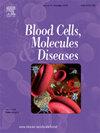Hb Lepore Rochester-MN,一种新的β - δβ双交叉血红蛋白变体
IF 1.7
4区 医学
Q3 HEMATOLOGY
引用次数: 0
摘要
β-珠蛋白基因簇含有高度同源的珠蛋白基因。涉及δ (HBD)和β (HBB)基因的交叉事件导致Lepore (δβ)和抗Lepore (βδ)血红蛋白(Hbs)。最近,双交叉(β - δβ)变异被报道。在此,我们报告了在我们实验室发现的βδβ变异,包括新的Hb Lepore Rochester-MN (LRM)。方法经机构审查委员会批准采集血样。蛋白质鉴定包括阳离子交换高效液相色谱(HPLC)、毛细管电泳(CE)和质谱(MS)。分子分析包括HBB Sanger测序和多重连接依赖探针扩增(MLPA)。结果鉴定出2个明显的βδβ交叉变异:Novel Hb LRM(2例婴儿,1例成人)和Hb Wanjiang。Hb LRM在蛋白质研究(HPLC, CE和MS)中分离,显示出与Hb Lepore-Hollandia相同的蛋白质特征,但其表达率更高。Sanger测序鉴定该变异为NM_000518.4(HBB):c。28 _68delins41 (p.Ser10_Glu23delins14TAVNALWGKVNVDA)。Hb Wanjiang蛋白不能通过常规方法(HPLC、CE和IEF)从Hb A中分离出来,但通过质谱和DNA测序鉴定为NM_000518.4(HBB):c。255年_264delinstttttctcag (p.A87_T88delinsSQ)。结论δ片段与β基因的拷贝中性结合不会使临床表型恶化。当与Hb s共遗传时,一些替换甚至可能具有保护作用。这些不常见的双交叉βδβ变异可能给实验室的诊断带来挑战,因为它们在蛋白质评估中可能被误认为是其他类似的变异。此外,它们可能需要专门的分析,如质谱、桑格测序或NGS。如果不考虑与δ-gene的比较,解释可能具有挑战性。本文章由计算机程序翻译,如有差异,请以英文原文为准。
Hb Lepore Rochester-MN, a novel βδβ double crossover hemoglobin variant
Introduction
The β-globin gene cluster harbors highly homologous globin genes. Crossover events involving the δ (HBD) and β (HBB) genes result in Lepore (δβ) and anti-Lepore (βδ) hemoglobins (Hbs). Recently, double crossover (βδβ) variants have been reported. Herein, we report βδβ variants identified in our laboratory including the novel Hb Lepore Rochester-MN (LRM).
Methods
Blood samples were obtained with Institutional Review Board approval. Protein characterization included cation exchange high performance liquid chromatography (HPLC), capillary electrophoresis (CE) and mass spectrometry (MS). Molecular analysis included HBB Sanger sequencing and multiplex ligation-dependent probe amplification (MLPA).
Results
Two distinct βδβ crossover variants were identified: Novel Hb LRM (2 infants, 1 adult) and Hb Wanjiang. Hb LRM separated on protein studies (HPLC, CE and MS) and showed identical protein characteristics as Hb Lepore-Hollandia, however, it was expressed at a higher percentage. Sanger sequencing characterized the variant as NM_000518.4(HBB):c.28_68delins41 (p.Ser10_Glu23delins14TAVNALWGKVNVDA). Hb Wanjiang protein did not separate from Hb A using routine methods (HPLC, CE and IEF) but was identifiable by MS and DNA sequencing as NM_000518.4(HBB):c.255_264delinsTTTTTCTCAG (p.A87_T88delinsSQ).
Conclusions
The copy neutral incorporation of δ segments into β gene does not worsen the clinical phenotype. Some substitutions may even have a protective effect when coinherited with Hb S. These uncommon double crossover βδβ variants can pose a diagnostic challenge for laboratories as they can be mistaken for other similar variants on protein evaluation. Also, they may require specialized analysis such as MS, Sanger sequencing or NGS. Interpretation can be challenging if comparison to δ-gene is not considered.
求助全文
通过发布文献求助,成功后即可免费获取论文全文。
去求助
来源期刊
CiteScore
4.90
自引率
0.00%
发文量
42
审稿时长
14 days
期刊介绍:
Blood Cells, Molecules & Diseases emphasizes not only blood cells, but also covers the molecular basis of hematologic disease and studies of the diseases themselves. This is an invaluable resource to all those interested in the study of hematology, cell biology, immunology, and human genetics.

 求助内容:
求助内容: 应助结果提醒方式:
应助结果提醒方式:


